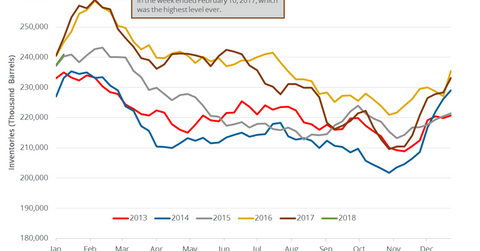Gasoline Inventories Could Cap the Upside for Oil Prices
On January 23, 2018, the API released its crude oil inventory report. US gasoline inventories increased by 4.1 MMbbls on January 12–19, 2018.
Nov. 20 2020, Updated 11:42 a.m. ET

US crude oil futures
March WTI crude oil (USO) (UCO) futures contracts rose 0.11% and were trading at $64.55 per barrel at 1:20 AM EST on January 24, 2018. Prices are at the highest level since December 2014. Higher oil (DWT) prices favor the Energy Select Sector SPDR ETF (XLE), which fell 0.2% to 77.9 on January 23, 2018.
Meanwhile, March E-Mini S&P 500 (SPY) futures contracts fell 0.02% to 2,839 at 1:20 AM EST on January 24, 2018.
API’s gasoline inventories
On January 23, 2018, the API (American Petroleum Institute) released its crude oil inventory report. US gasoline inventories increased by 4.1 MMbbls (million barrels) on January 12–19, 2018.
Wall Street analysts estimated that US gasoline inventories would have risen by 2.5 MMbbls during the same period. A larger-than-expected increase in gasoline inventories could pressure gasoline (UGA) and oil (SCO) prices.
Volatility in oil (OVX) prices impacts energy companies (IXC) (IYE) like SM Energy (SM), Hess (HES), and Callon Petroleum (CPE).
Moves in gasoline prices impact US refining (CRAK) companies like Valero (VLO), Holly Frontier (HFC), and PBF Energy (PBF).
API’s distillate inventories 
US distillate inventories declined by 1.28 MMbbls on January 12–19, 2018, according to the API. Wall Street analysts estimated that US distillate inventories could have declined by 1.47 MMbbls during the same period. Any decline in distillate inventories could have a positive impact on diesel and oil (USL) prices.
Next, we’ll discuss US gasoline demand.
